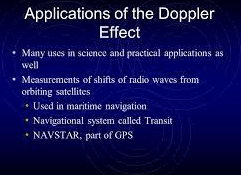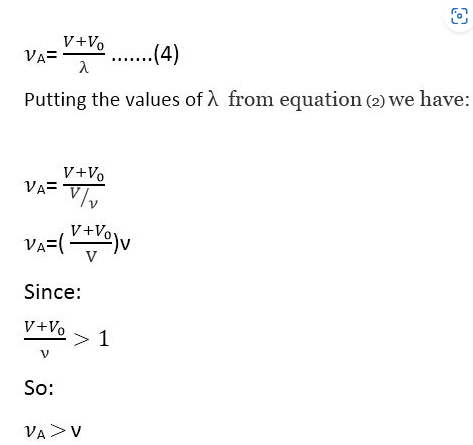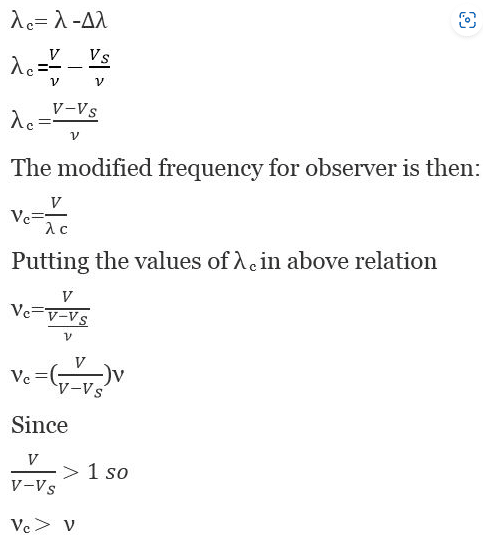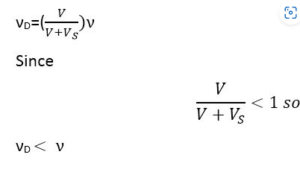What are some Applications of Doppler Effect?
What is Doppler effect?
“The apparent change in the frequency due to relative motion between source and observer is known as Doppler effect.”
When a listener is in motion toward a stationary source of the sound, the pitch (frequency) of the sound heard is higher than when the listener is at rest. If the listener is in motion away from the stationary source, a lower pitch is heard. We obtain similar results when the source is in motion toward or away from a stationary listener. The pitch of the whistle of a locomotive or the siren of a fire engine is higher when the source is approaching the hearer than when it has passed and receded.
In a paper written in 1842, Christian Johann Doppler (1803 – 1853, Austrian) called attention to the fact that the motion of the body and the observer. This Doppler effect, as it is called, applies to waves in general. Doppler himself mentions the application of his principle to sound waves. An experimental test was carried out in Holland in 1845 by Buys Ballot, “using a locomotive drawing an open car with several trumpeters.”
An important phenomenon observed in waves is the Doppler effect. This effect shows that if there is some relative motion between the source of waves and the observer, An apparent change in the frequency of the waves is observed.
This effect was observed by Johann Doppler while he was observing the frequency of light emitted from distant stars. In some cases, the frequency of light emitted from a star was found to be slightly different from that emitted from a similar source on the Earth. He found that the change in frequency of light depends on the motion of stars relative to the Earth.
This effect can be observed with sound waves also. When an observer is standing on a railway platform, the pitch of the whistle of an approaching locomotive is heard to be higher. But when the same locomotive moves away, the pitch of the whistle becomes lower.
The change in the frequency due to the Doppler effect can be calculated easily if the relative motion between the source and the observer is along a straight line joining them. Suppose v is the velocity of the sound in the medium and the source emits a sound of frequency f and wavelength λ. If both the source and the observer are stationary, then:
V = νλ ……..(1)
λ = V/ν ………(2)
ν =V/λ …………(3)
There are four possible cases to discuss the Doppler effect.
4 cases of doppler effect
Case 1:When observer moves towards the stationary source of sound:
If the observer moves towards the source with a velocity v0. The relative velocity of the waves and the observer is
v +v0
Now the number of waves received in one second or changed frequency νA is given by:

Thus the pitch of the sound increases.
Case 2:When observer moves away from the stationary source of sound:
If the observer moves towards the source with a velocity V0. The relative velocity of the waves and the observer is:
V – V0.
Now the number of waves received in one second or changed frequency νB is given by:

Thus the pitch of the sound decreases.
Case 3:When source of sound moves towards the stationary observer:
Suppose the source of sound waves is towards the stationary observer with velocity V0 . Now in one second, the waves are compressed by an amount known as Doppler shift represented by Δλ, so:
VS =ν Δλ
Δλ = VS/ν …………..(6)
The compression of waves is due to the fact that the same number of waves are contained in a shorter space depending upon the velocity of the source. The wavelength for the observer is then:

Thus the pitch of the sound increases.
Case 4:When source of sound moves away from stationary observer:
Suppose the source of sound moves with velocity Vs away from the stationary observer. Now the modified frequency of the sound waves heard by the observer will be:

Thus the pitch of the sound decreases.
Doppler effect Applications
- The Doppler effect is also applicable to electromagnetic waves. One of its important applications is the radar system, which uses radio waves to determine the elevation and speed of an aeroplane. A radar is a device, which transmits and receives radio waves. If an aeroplane approaches the radar, then the wavelength of the wave reflected from the aeroplane would be shorter if it moves away. Similarly, the speed of satellites moving around the Earth can also be determined by the same principle.
- Sonar is an acronym derived from “sound navigation and ranging”. The general name for sonic or ultrasonic underwater echo-ranging and echo-sounding system. Sonar is the name of a technique for detecting the presence of objects underwater by the acoustical echo.
In sonar “Doppler detection” relies upon the relative speed of the target and the detector to provide an indicator of the target speed. It employs the Doppler effect, in which an apparent change in frequency occurs when the source and the observer are in relative motion to one another. Its known military applications include the detection and location of submarines, control of antisubmarine weapons, mine hunting and depth measurement of sea.
- Astronomers use the Doppler effect to calculate the speeds of distant stars and galaxies. By comparing the line spectrum of light from the star with light from a laboratory source, the Doppler shift of the star’s light can be measured. Then the speed of the star can be calculated.
Stars moving towards the Earth show a blue shift. This is because the wavelength of light emitted by the star is shorter than is the star had been at rest. So, the spectrum is shifted towards a shorter wavelength, i.e., the top of the blue end of the spectrum.
Stars moving away from the Earth show a redshift. The emitted waves have a longer wavelength than if the star had been at rest. So the spectrum is shifted towards a longer wavelength i.e., towards the red end of the spectrum. Astronomers have also discovered that all the distant galaxies are moving away from us and by measuring their redshift, they have estimated their speeds.
- Another important application of the Doppler shift using electromagnetic waves is the radar speed trap. Microwaves are emitted from a transmitter in short bursts. Each burst is reflected off any car in the path of microwaves in between sending out bursts. The transmitter is open to detect reflected microwaves. If the reflection is caused by a moving obstacle, the reflected microwaves are Doppler-shifted. By measuring the Doppler shift, the speed at which the car moves is calculated by a computer programme.
See also video of Doppler effect and its applications:
For related Topics visit our page: Sound and oscillations